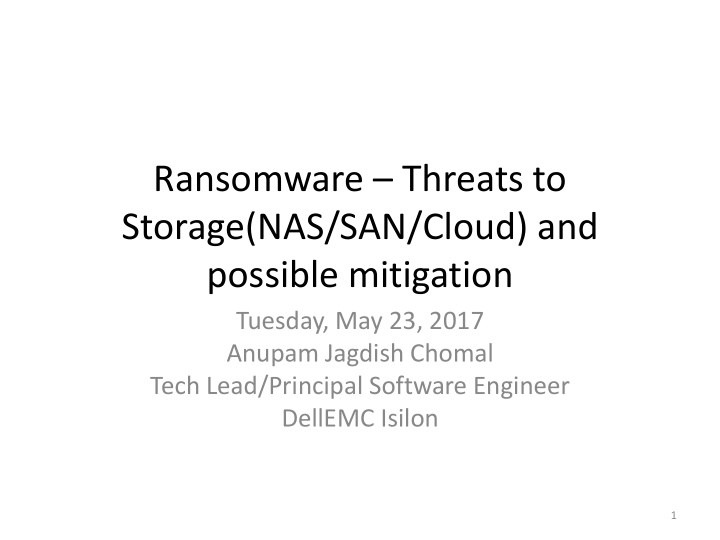



Ransomware – Threats to Storage(NAS/SAN/Cloud) and possible mitigation Tuesday, May 23, 2017 Anupam Jagdish Chomal Tech Lead/Principal Software Engineer DellEMC Isilon 1
Who am I? – The Eternal Question • Who am I? – Principal software engineer at DellEMC – Veritas, LSI, Nevis networks Lineage – Mtech Computer Science, IITB • Why this topic? 2
Agenda • How Malware/Ransomware works? • Types of Ransomware • Top Ransomwares • Top research papers in this area • Top Attacks • How to protect against Ransomware 3
How Malware Works • Exploit a vulnerable application • A payload is downloaded • Attacker gets command and control of compromised system • This allows for privilege escalation and ultimately the acquisition of high value informational assets 4
How a Malware Infects • Mutexes are used by malware creators to overcome the effect made by the different instances of the same malware on the system • When the trojan infects a system, then first of all try to obtain a handle to a “named” mutex, if the process fails, then the malware exits • One of the easiest way to check whether mutex is present is “ CreateMutex Function”. This function is used by malwares for checking if the system is infected so one approach to detect the presence of existence of malware is trying to obtain a handle to the created mutex 5
What are Attack Vectors? • An attack vector is a path or means by which a hacker (or cracker) can gain access to a computer or network server in order to deliver a payload or malicious outcome. • Attack vectors enable hackers to exploit system vulnerabilities, including the human element. • Attack vectors include viruses, e-mail attachments, Web pages, pop-up windows, instant messages, chat rooms, and deception. 6
Types of Ransomware • There are basically two types of Ransomware – Locker Ransomware – Crypto Ransomware • In memory Ransomwares 7
Top Ransomwares of 2016 • WannaCry • Locky • CryptoWall • SamSam • Jigsaw • Chimera https://www.tripwire.com/state-of- security/security-data-protection/cyber- security/top-10-ransomware-strains-2016/ 8
Wannacry (Source - Kaspersky Lab) • In these attacks, data is encrypted with the extension “.WCRY” added to the filenames • The attack, dubbed “ WannaCry ”, is initiated through an SMBv2 remote code execution in Microsoft Windows • This exploit (codenamed “ EternalBlue ”) has been made available on the internet through the Shadowbrokers dump on April 14th, 2017 and patched by Microsoft on March 14 • Unfortunately, it appears that many organizations have not yet installed the patch 9
Wannacry - Contd • Unpatched Windows computers exposing their SMB services can be remotely attacked with the “ EternalBlue ” exploit and infected by the WannaCry ransomware • For command and control, the malware extracts and uses Tor service executable with all necessary dependencies to access the Tor network • https://securelist.com/blog/incidents/78351/wan nacry-ransomware-used-in-widespread-attacks- all-over-the-world/ 10
Wannacry - Contd 11
Best Papers – Cutting the Gordian Knot: A look under the hood of Ransomware attacks • Kharraz, Amin; Robertson, William; Balzarotti, Davide; Bilge, Leyla; Kirda, Engin • DIMVA 2015, 12th Conference on Detection of Intrusions and Malware & Vulnerability Assessment, July 9-10, 2015, Milan, Italy • http://www.eurecom.fr/en/publication/4548/ download/rs-publi-4548.pdf 12
PayBreak: Defense Against Cryptographic Ransomware • Eugene Kolodenker Boston University & MITRE, Boston, MA, USA • Proceeding - ASIA CCS '17 Proceedings of the 2017 ACM on Asia Conference on Computer and Communications Security 13
UNVEIL: A Large-Scale, Automated Approach to Detecting Ransomware • Amin Kharaz and Sajjad Arshad, Northeastern University; Collin Mulliner, Square, Inc.; William Robertson and Engin Kirda, Northeastern University • August 2016 – USENIX Security Symposium • https://www.usenix.org/system/files/conferen ce/usenixsecurity16/sec16_paper_kharraz.pdf 14
CryptoLock (and Drop It): Stopping Ransomware Attacks on User Data • Nolen Scaife - University of Florida • Henry Carter - Villanova University • 2016 IEEE 36th International Conference on Distributed Computing Systems • https://www.cise.ufl.edu/~traynor/papers/sca ife-icdcs16.pdf 15
Top Attacks • Attack against UK hospital system (NHS) http://phishing.it.umn.edu/2017/05/krebs-uk-hospitals-hit- in-widespread.html • Hollywood Presbyterian Medical Center - After the hospital’s network data was encrypted, they were forced to pay 40 bitcoins, or about $17,000 dollars to decrypt the data • San Francisco Metro System - http://thehackernews.com/2016/11/transit-system- hacked.html • The IOT Ransomware threat https://iotsecurityfoundation.org/the-iot-ransomware- threat-is-more-serious-than-you-think/ 16
How to Protect? • Plan for the possibility • Backup regularly – but caution • Patch all systems regularily • Use a firewall • Antivirus(Signatures) and Machine learning • Best Practices – Check for permissions. Read-Only when write not needed – Review access control settings – Don’t give administrative privileges when not needed 17
References • http://www.business- standard.com/article/economy-policy/how- hackers-are-minting-digital-cash-through-global- ransomware-attacks-117051700151_1.html • http://blog.checkpoint.com/2017/03/22/ransom ware-not-file-encryption/ • https://www.sans.org/reading- room/whitepapers/incident/deployment-flexible- malware-sandbox-environment-open-source- software-36207 18
Recommend
More recommend